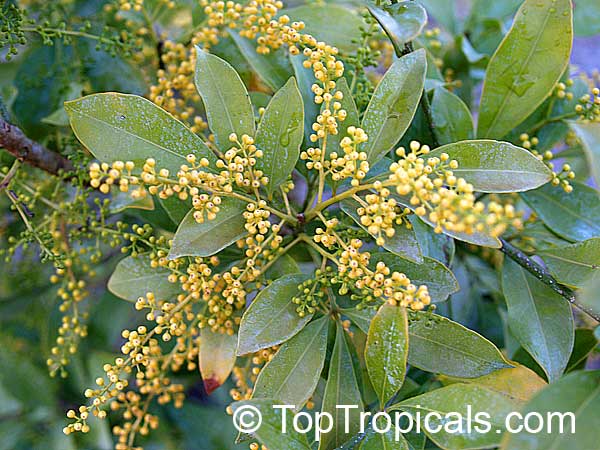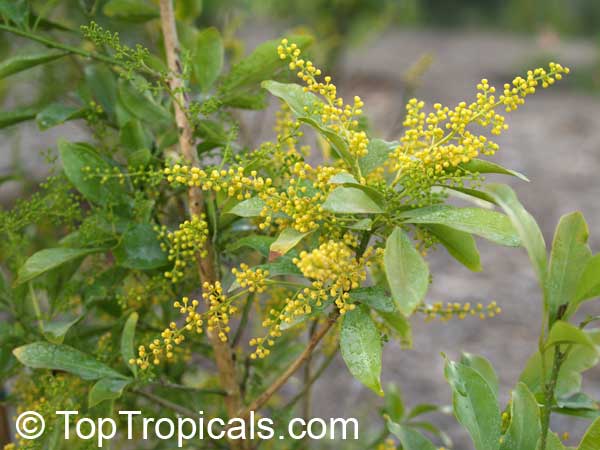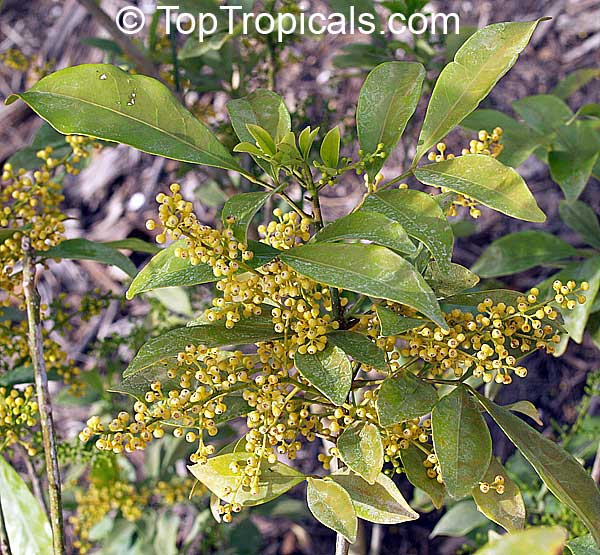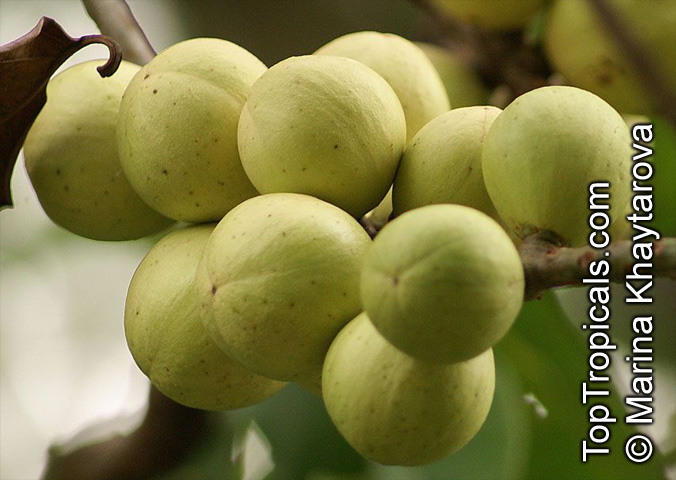Meliaceae - Botanical Family
Top Tropicals Plant Encyclopedia
| Number of plants found: 22 | Next | 
|
Go to page: | 1 | 2 | 3 |
Botanical name: Aglaia argentea
Common name: Silver Boodyarra
Family: Meliaceae
Origin: Southeast Asia





Botanical names: Aglaia korthalsii, Aglaia aquatica, Aglaia cauliflora
Common names: Aglaia, Sang Kreyt
Family: Meliaceae
Origin: Southeast Asia






Aglaia korthalsii, commonly known as Aglaia, is a small tropical tree native to Southeast Asia, from China to India. This species of tree is known for its unique properties, being an ethnomedical plant as well as edible, and is therefore grown commercially throughout the region. It is able to grow to heights of 10-20 feet tall, with extremely large specimens sometimes reaching heights of 20 feet or more.
When grown in a USDA zone ranging from 9-11, Aglaia korthalsii requires regular watering in order to survive and thrive. Unless temperatures abruptly drop below zero, it is not necessary to provide supplemental water during the winter in these climates. However, during the hot summer months it is important to provide the tree with moderate amounts of water.
Aglaia korthalsii is highly valued for its edible fruit. These fruits are ellipsoid to subglobose, ranging from 20 - 40mm in length and 10 - 50mm in width, and are orange in color. Each individual fruit contains up to 3 edible seeds, surrounded by a thin layer of edible flesh. These fruits carry numerous health benefits and are commonly used in local recipes of Southeast Asia. On average, it can produce up to 20 fruits per season, making it an excellent source for edible yield.
In colder climates, Aglaia korthalsii can be successfully grown in a pot. It is important to choose a pot that is large enough to accommodate its growth (at least 18 - 22 inches in diameter) and to use quality potting soil to ensure proper drainage. Furthermore, in cold climates it is necessary to bring the pot into a sheltered area during the winter months to ensure its survival. With the right care and maintenance, this beautiful tree can be a great addition to any landscape.
Botanical name: Aglaia odorata
Common names: Chinese Perfume Plant, Chinese Rice Flower, Mock Lemon
Family: Meliaceae
Origin: South China









This plant is an easy to grow bush. It produces fragrant yellow flowers - that are as small as a grain of rice, with a very strong perfume. The fragrance is outstanding! Aglaia has many medical uses: odorine and odorinol obtained from this plant has cancer chemopreventive activity. Relatively cold-tolerant.
See Article about this plant.
Recommended Fertilizer: SUNSHINE Pikake - Fragrant Flower Booster
Botanical name: Aglaia odorata var. gigantea
Common names: Giant Rice Flower, Perfume Flower
Family: Meliaceae
Origin: Thailand





Aglaia odorata var. Gigantea has small, pungent yellow-orange flowers that are usually seen in the warmer spring months. On a settled day, their sweet perfume is often recognizable from a distance. The flowers are followed by small, round brown-black fruits that can be used for making tea.
In the proper locations in USDA hardiness zones 9-11, this plant can be grown in the ground without any special requirements. In colder areas it can be successfully grown in a container provided it is moved indoors to a warm spot during the winter. In colder climates the plant will require more attention in order to survive winter weather. In any case, the soil must be kept moist at all times and fertilizer should be added once a month during the growing season. Pruning should be done in early summer before the flowering period.
In order to maximize its beauty, Aglaia odorata var. Gigantea should be grown in full sun or semi-shade. It prefers well-draining soils and should not be over-fertilized as this will reduce its flowering ability. During the summer and fall months, it should be given a deep watering every week to keep its foliage and flowers at their best.
Botanical names: Aglaia sapindina, Aglaia novaguineensis
Common name: Luka-luka Ma
Family: Meliaceae
Origin: Australia , Indonesia, Papua New Guinea







Native to Australia, Indonesia, and Papua New Guinea, the Aglaia sapindina (Luka-luka Ma) is an evergreen small tree that can reach 10-20 feet in height with a low canopy. It prefers full sun to semi-shade and responds well to regular water needs. The Aglaia sapindina is known to have 4-5 inches long panicles that contain small, yellow flowers. It bears fruit around late summer. The small yellow to orange flowers are fragrant and are known to attract butterflies and hummingbirds.
Growing the Aglaia sapindina in USDA Zones 9-11 is fairly easy. The shrub prefers well-drained, humus-rich soil and needs to be planted in a spot that receives sun to partial shade. It will benefit from regular watering during the warmer months, but should not be allowed to stand in water for extended periods of time. When planting in colder regions, it is best to keep the shrub in a container and bring it indoors during the winter. During the colder months, Luka-Luka Ma should be placed in a bright, warm area and watered regularly. It will also benefit from occasional fertilizing, but should not be overfed.
Botanical names: Aphanamixis polystachya, Amoora aphanamixis, Amoora rohituka
Common names: Pasak Lingga, Pithraj, Rohitak
Family: Meliaceae
Origin: India






Botanical names: Azadirachta indica, Antelaea azadirachta
Common names: Neem tree, Nim, Margosa Tree, Vepa, Nimbay, Yepa, Pichumarda
Family: Meliaceae
Origin: India and Burma










The family includes about 50 genera and 550 species, both tropical and subtropical, with many of them prized for their wood, edible fruits, and ornamental qualities. A. indica is pinnate-leafed, has unwinged seeds. Outdoors, in locations where temperatures don't drop much below freezing, it may reach up to 50 feet tall. It will grow where rainfall is as little as 18 inches per year and thrives in areas that experience extreme heat of up to 120 degrees F. They are reported to live for up to 200 years. The people of India have long revered the neem tree (Azadirachta indica). For centuries, millions have cleaned their teeth with neem twigs, smeared skin disorders with neem-leaf juice, taken neem tea as a tonic, and placed neem leaves in their beds, books, grain bins, cupboards, and closets to keep away troublesome bugs. The tree has relieved so many different pains, fevers, infections, and other complaints that it has been called "the village pharmacy." As long as 4,000-4,500 years ago, various parts of the neem tree were used in beauty and medicinal products by the ancient East Indian Harappa. India, Sri Lanka, Bangladesh, and other areas of southern Asia currently include this plant extract in soap, toothpaste, and other personal products. Most recently, neem-based products have found their way into the American and European mainstream markets. The plant used cosmetically and medicinally by many cultures for centuries, also offers an environmentally safe alternative to synthetic pesticides as well. A. indica extract has been used to treat a wide range of ailments, including wounds, burns, sprains, bruises, earache, headache, fever, sore throat, shingles, fungal infections, acne, skin diseases, ulcers, and periodontal diseases. Extracts from this plant are also currently being investigated for use against retroviruses, such as the AIDS virus; for treating cancer, diabetes, and allergies; and for birth control in both men and women. A. indica insecticidal properties were recognized by the native Americans, who used it as a tick repellent. See more facts about Neem Tree and Article about Neem tree.
Almost every part of the tree is useful: leaves brewed as tea or applied to skin, twigs chewed as toothbrushes, seeds pressed into neem oil for garden pest control, and ripe fruit eaten fresh. In India, Neem is planted for shade, clean air, and natural insect protection.
Easy to grow in hot, dry conditions with little care. Drought tolerant, fast-growing, and evergreen, Neem is a practical tree for tropical and subtropical gardens.
Learn more: Neem - Free Tree of India.
Recommended Fertilizer: SUNSHINE Robusta - Rapid Growth Booster
Botanical name: Carapa guianensis
Common names: Crabwood, Andiroba, Bastard-mahogany
Family: Meliaceae
Origin: Tropical America








Native to the tropical forests of South America, Carapa guianensis, commonly known as Crabwood or Andiroba, is an impressive tree that can reach heights of more than 20 feet. At maturity, the tree trunk can become quite large and its bright green leaves, which remain evergreen through most of the year, can reach 3-5 inches long. This tree boasts showy clusters of white and off-white flowers that appear in spring and summer, giving rise to edible fruits with hairy brown and orange nuts.
Andiroba's ethnomedical uses are quite impressive, since the oil from its seeds is an effective agent for treating skin conditions, insect repellent, and even furniture polish. Its wood is highly sought after by sawmills due to its soft yet durable properties. In addition, Andiroba is a flood-tolerant tree, being able to survive in flooded conditions for extended periods of time.
Growing and caring for Andiroba is possible in USDA Zones 9-11, although it is best suited for warmer climates. When it comes to placement, Andiroba will prefer full sun and semi-shade, and regular watering is a must. In cold regions, it is recommended to plant Andiroba in a pot and keep it indoors during cold months, in order to ensure proper care and avoid freezing during freezing temperatures.
Botanical name: Cedrela fissilis
Common names: Cedro Blanco, Brazilian Cedarwood
Family: Meliaceae
Origin: Central and South America



Cedrela fissilis is an interesting and rare deciduous tree with velvety stalks bearing dark green leaves and yellow-green flowers in large, foot long clusters. The fruit, a woody capsule, splits to form a 5 point star when mature.
Botanical name: Chukrasia tabularis
Common names: Burmese Almondwood, Chickrassy, Chittagong Wood
Family: Meliaceae
Origin: Southeast Asia, India









| Next |  |
Use link to repeat this search:
https://toptropicals.com/cgi-bin/garden_catalog/cat.cgi?search_op=and&keyword_op=and&language=e&family=Meliaceae&number=10
&no_change_lang=1&user=tt&sale=1&first=0


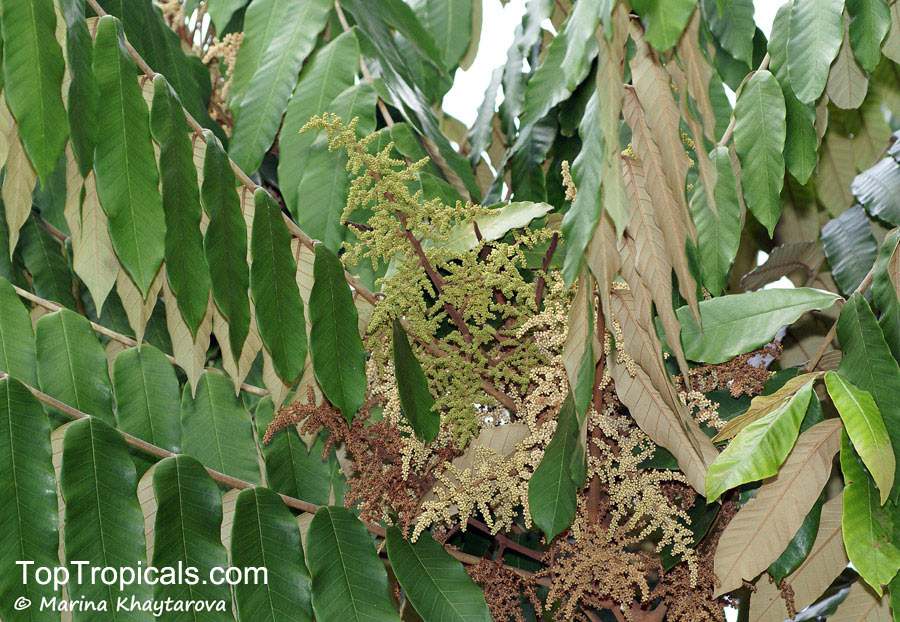






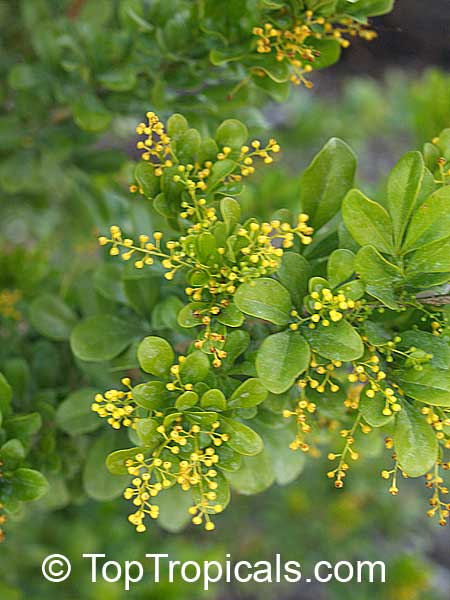










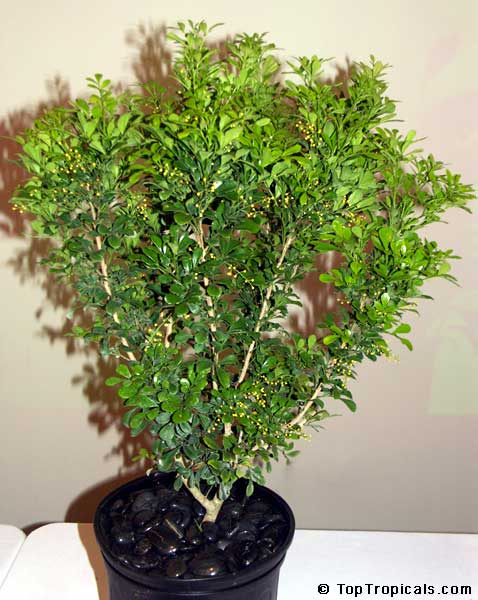













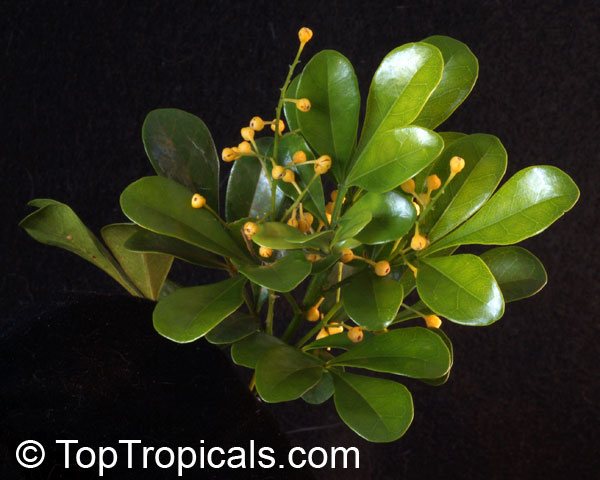






 SUNSHINE Pikake (NPK 2-2-4) - eco-friendly concentrated nutrition booster for fragrant flowers. Improves quantity and quality of flowers. Encourages profuse blooming. Increases flower fragrance intensity. Can be used with every watering. For best results, use in combination with
SUNSHINE Pikake (NPK 2-2-4) - eco-friendly concentrated nutrition booster for fragrant flowers. Improves quantity and quality of flowers. Encourages profuse blooming. Increases flower fragrance intensity. Can be used with every watering. For best results, use in combination with 



